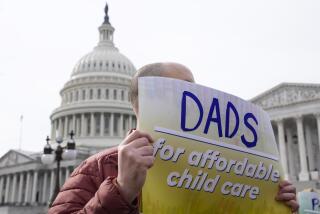U.S. Should Mandate Leaves for Child-Care
RUTGERS, N.J. — The United States is the only industrialized nation without laws guaranteeing leave to care for a newborn child: 75 other countries have provisions for leaves with job guarantees, often with cash benefits. By contrast, one study finds that only about 50% of large U.S. firms even offer women an unpaid child-care leave. Still fewer men have the option of taking leave to care for a newborn.
The need for a nationwide parental-leave policy is obvious. As Rep. Patricia Schroeder (D-Colo.) pointed out in a congressional hearing last fall, 96% of fathers and more than 60% of mothers work outside the home.
Women with children under the age of 3 make up the fastest-growing segment of the U.S. work force, the Bureau of Labor Statistics has reported, and almost half of women with children under 1 year old are working outside the home--as compared with 34% as recently as 1979.
A recent study by Catalyst, a national nonprofit organization, found that of 119 major corporations offering paternity leave, 41% said it was not appropriate for a man to take any time off at the birth of a child. All employers have been required since 1978, under terms of the Pregnancy Discrimination Act, to treat women when disabled by pregnancy the same way as they treat other employees disabled by short-term illnesses and injuries. Under terms of the 1964 Civil Rights Act, employers offering child-rearing leave must make it available on a sex-neutral basis. However, only about half the companies surveyed allowed women to add to their disability period with an unpaid leave and a guaranteed job return.
Congress next month will consider legislation to bring the United States into conformity with most industrialized nations. The Parental and Medical Leave Act (HR 4300), introduced by Rep. William D. Clay (D-Mo.), would meet two important needs of today’s workers. Like a similar bill introduced last year by Rep. Schroeder, Clay’s bill would guarantee employees their jobs or equivalent ones for up to 26 weeks a year of temporary medical leave and 18 weeks every two years of parental leave. The Clay legislation, however, meets the often-voiced concern for small employers by exempting those with fewer than five employees and includes an administrative as well as a judicial enforcement mechanism. (The Senate is considering a nearly identical bill, S 2278, introduced by Sens. Christopher J. Dodd (D-Conn.) and Arlen Specter (R-Pa.).)
Parental leave would include time off to care for newborns, newly adopted children and children who have serious health conditions. The Clay measure also calls for a commission to recommend--after no more than two years’ study--legislation providing for paid leaves.
While medical leaves are necessary for the 85% of women workers who will bear children while employed, testimony at recent hearings on HR 4300 made plain that other workers need medical leaves too. A Vietnam veteran who earned three purple hearts told a subcommittee of suffering serious back injury. He needed post-surgery therapy and arranged to do his week’s work at a federal agency in four 10-hour days. When a new supervisor found this unacceptable, it became clear that the veteran’s ability to ensure satisfactory unpaid leave for medical reasons was not protected.
As a measure addressing the needs of women in the paid work force, Clay’s bill has several strengths.
First, it is a vital step in accommodating the demands of family and work. As such, it is an important sequel to the Pregnancy Discrimination Act and other anti-discrimination provisions which only require employers to be evenhanded in the benefits they choose to give.
Second, by sharply distinguishing needs associated with child rearing from those associated with child bearing, the bill clearly guarantees a father’s right to child-care leaves, a right that has usually been invisible in “maternity leave” policies and programs.
Third, by treating temporary incapacities of pregnancy like other temporary incapacities, the Clay bill eliminates a source of resentment between workers who miss work for pregnancy-related reasons and workers who miss work for equally compelling problems. This approach also minimizes the chances that employers will perceive women of child-bearing age as potentially more expensive employees and therefore hesitate to hire them. More generally, by encouraging people of both sexes to see similarities in their experiences, it may help to diffuse the view of women as mothers--and only mothers--a view that has tended to limit women’s opportunities.
But the Clay bill has some serious shortcomings as well. The failure to provide for paid leaves means that leaves will not be a realistic option for low-income parents. Moreover, even where a family can afford the loss of one income, economic necessity means that most likely the woman’s income is the one that will be lost, regardless of which parent most wants to engage in child care. In the case of medical leaves, wage replacement often makes the difference between economic ruin and economic viability for families. However definite a commission’s mandate to propose legislation providing benefits within a specific period of time, such proposals do not serve the same purposes as actual payments.
Another serious shortcoming is failure to provide leaves for the care of other relatives and dependents. Demographic trends make clear that the care needs of the elderly will far exceed those of small children. Current projections suggest that by 1990 there will be 19.2 million children under 5 years old as compared with 19.7 million people 65 and over who receive Medicare. By 2025 the number of older persons needing health care will be more than twice the number of children under 5. And, like child care, caring for the elderly is a burden borne primarily by women.
It is time that the United States, like the overwhelming majority of modern nations, recognizes and accommodates the human needs that compete with work.
More to Read
Sign up for Essential California
The most important California stories and recommendations in your inbox every morning.
You may occasionally receive promotional content from the Los Angeles Times.










